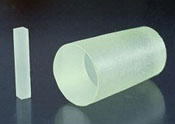Scintillator Crystals
SCINTILLATORS
 Marketech offer a wide range of scintillation crystals. Below is a list of our most popular scintillation crystals offered along with a property tables.
Marketech offer a wide range of scintillation crystals. Below is a list of our most popular scintillation crystals offered along with a property tables.
Additional information and inquiries for other crystals are welcomed. Please contact us by phone in the US at 360-379-6707, by fax 360-379-6907 or by email at: [email protected].
Scintillator Detector Types (PDF 129k)
Download this page as a PDF (PDF 132k)
Click Crystal Names for more information
NaI:Tl - YAP:Ce - YAG:Ce - BGO - CaF:Eu - CsI:Tl - LuAG:Ce -
GSO - CWO - PWO - NBWO - ZnSe(Te)
Nal:Tl
Sodium iodide activated by thallium has long been the scintillation standard. Nal:Tl has good performance, economical price, high luminescence efficiency, very good spectroscopic performance and no significant self absorption of the scintillated light.
YAP:Ce
Yttrium aluminum perovskite activated by cerium is a fast, mechanically strong and chemically resistant scintillation material. Mechanical properties enable precise machining and entrance windows can be made with a very thin aluminum layer deposited directly on the entrance surface of the crystal. YAP:Ce scintillators have very low energy secondary X-ray emissions which makes them desirable for imagining applications. YAP:Ce detectors are used for gamma and X-ray counting, electron microscopy, electron and X-ray imaging screens, and tomography systems.
YAG:Ce
Yttrium aluminum garnet activated by cerium is fast with excellent mechanical properties and is chemically resistant scintillator. Mechanical properties enable to produce YAG:Ce scintillation screens down to a thickness of 30 µm. YAG:Ce detectors are excellent for electron microscopy, beta and X-ray counting, electron and X-ray imaging screens.
BGO
Bismuth germanate is intrinsic scintillation material with high absorption power. Due to its high effective atomic number and high density, BGO is a very efficient gamma absorber with high photo effect fraction which results in a very good photo peak to Compton ratio. BGO detectors are preferred for medium and high-energy gamma counting and high-energy physics applications.
CaF:Eu
Calcium fluoride activated by Europium is light scintillators are used for detection of charged particles and soft gamma ray up to several hundreds keV. CaF:Eu is typically used for detection of beta rays due to its relatively small back scattering. It is not suitable for detection of high-energy gamma ray because has a small photo fraction. It is non hygroscopic and is relatively chemically inert.
CsI:Tl
Cesium Iodide activated by thallium is a scintillation material with high absorption power and can be used as an efficient gamma ray absorber. CsI:Tl is soluble in water, but is not hygroscopic in laboratory conditions. It has high resistance to mechanical and thermal shocks. CsI:Tl can be easily fabricated into wide variety of shapes and geometries. It can be also fabricated into detection matrices.
LuAG:Ce
Lutetium Aluminum Garnet activated by Cerium (chemical formula Lu3Al5O7) is relatively dense and fast scintillation material. Its density of 6.73 g/cm3 is about 94 % of density of BGO (7.13 g/cm3). Decay time is much faster (70 ns) compared to BGO (300 ns). This is advantage for time dependent and coincidence measurements.
Wavelength of scintillation emission is about 535 nm, similar as BGO (480 nm), which is ideal for Photodiode and Avalanche Diode readout. This material can by used also for Imaging Screens, similarly to YAG:Ce. The advantage of LuAG:Ce is its higher density allowing for thinner screens with higher spatial resolution. The material is mechanically and chemically stable, it can be machined to variety of shapes and sizes including prisms, spheres, and very thin plates.
Its primary advantage high density, fast decay time, a wavelength of luminescence emission well suitable for photodiode and avalanche diode readout, chemical, mechanical, and temperature resistance make it an ideal choice for PET scanners, high energy gamma and charge particle detection, and high spatial resolution Imaging Screens for Gamma, X, Beta and UV ray
GSO
Gadolinium silicate doped with cerium is a "fast" crystal and can be used as a protection scintillator. Its possible applications include computer tomography, spatial resolution of less than 1 mm. Is the most promising for spectrometry and radiometry of gamma-radiation in the low energy range (<1 MeV). Has good temperature stability, due to which can be used in system equipment.
CWO
Cadmium tungstate CdWO4 (CWO), due to its low intrinsic background and afterglow together with sufficiently high light yield, is the most promising for spectrometry and radiometry of radio nuclides under extremely low activities, and also for computer tomography. Technology of its production is also well developed.
PWO
Lead tungstate PbWO4 (PWO) is a new "heavy" highly efficient and "fast" scintillator for high energy physics. It has the shortest radiation length and Moliere radius among the known scintillators, satisfactory light yield for this energy range, high radiation stability. Production technology which is under continuous development allows to prepare uniform scintillators ensuring high energetic and special resolution of the detecting assembles on accelerators.
NBWO
Double tungstate of sodium and bismuth NaBi(WO4)2 (NBWO) is also a new "heavy", "fast" and optically dense oxide single crystal. Is used as a Cherenkov radiator.
ZnSe(Te)
ZnSe(Te) single crystals are characterized by the unique combination of high conversion efficiency, intrinsic luminescence in the red region of spectrum, high thermal and radiation stability; they are not hygroscopic, and afterglow is practically absent. Production technology has been developed of "fast" and "slow" scintillation crystals with different decay times and intrinsic luminescence maximum wavelengths.
ZnSe(Te) crystals are not toxic, moisture-resistant, conserve working parameters after gamma-irradiation up to 107 Rad and continuous heating up to 400 K. These qualities make ZnSe(Te) an excellent material for multi-purpose ionizing radiation detectors of the "scintillator-silicon photodiode" type. They are used for radiation monitoring, medical and technical tomography, X-ray medical devices, non-destructive testing systems, customs inspection, spectrometry of alpha- and beta-radiation, as well as soft X-rays.

.JPG)